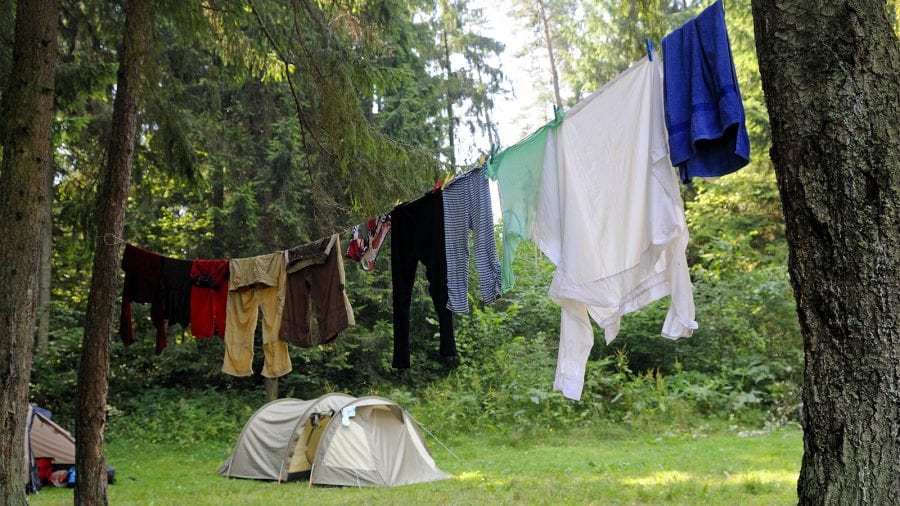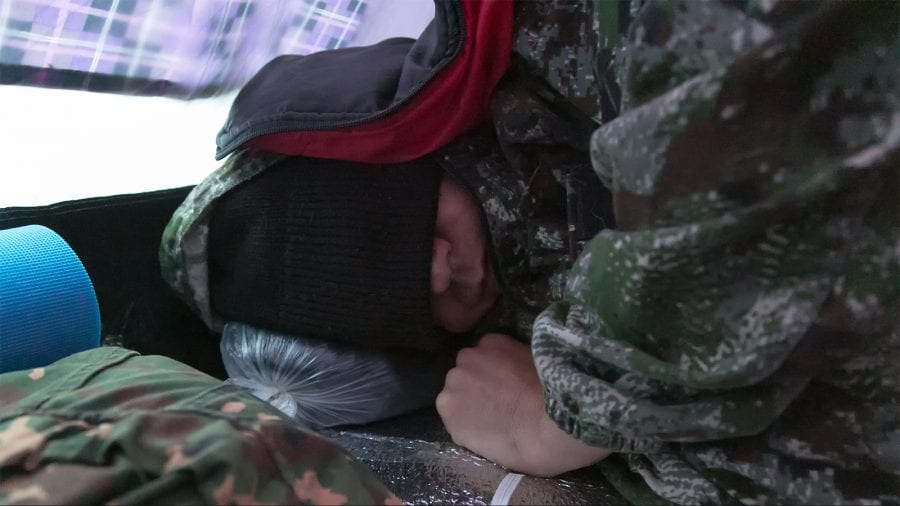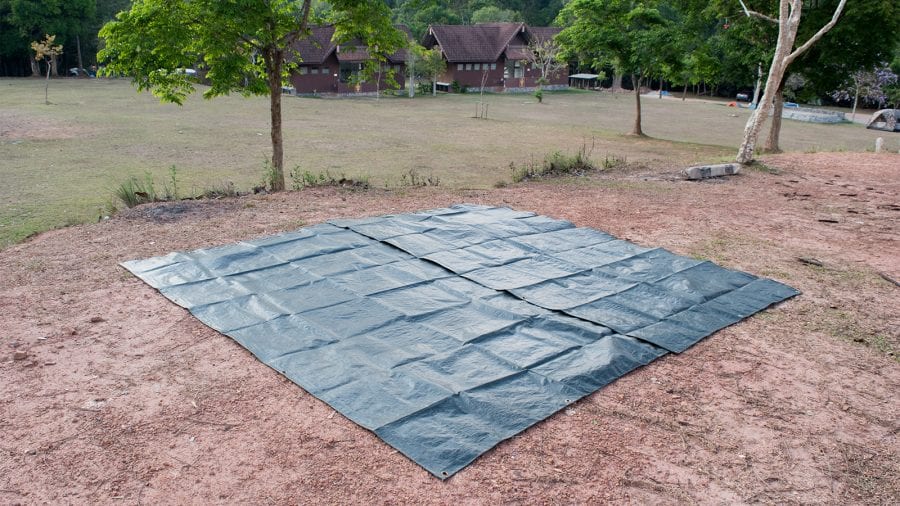We all dream of enjoying beautiful, sunny skies while camping, but sometimes the weather just doesn’t want to cooperate with our plans.
The good news is that it is possible to camp in the rain – and enjoy yourself – so long as you come prepared for the elements.
To help you make the most of your upcoming adventures, regardless of the weather, here are our top tips for camping in the rain.
1. Have the proper rain gear

First things first, if you’re going camping in a damp locale, such as the temperate rainforests of Olympic National Park, it’s imperative that you have quality rain gear at the ready. This means packing a solid set of rain pants and a rain jacket to help keep you dry at all times.
Your rain gear should be made from a waterproof breathable fabric, like Gore-Tex, eVent, or BDry so that you can still hike and move around camp in the rain without sweating profusely.
It’s also a good idea to look for a rain jacket and a pair of rain pants that have side zippers or pit zips as these can be helpful when it comes to ventilating in very warm conditions.
2. Waterproof your tent before leaving home

If you’ve just purchased a new tent, chances are pretty high that it will come properly waterproofed right out of the package. However, after a few camping trips, your tent will need to be re-waterproofed using a tent waterproofing spray to ensure peak performance in the backcountry.
Also, keep in mind that many tents need to be re-seam sealed every few months. This process is fairly straightforward, though it’s a bit time-consuming, so be sure to set aside a few hours every month to keep your shelter in peak condition.
Read More : How to Re-waterproof A Tent
3. Bring a tarp for cooking and relaxing

Your tent is your respite from the rain at night, but when you’re just lounging around camp, you’ll likely want to set up a covered living space.
The answer? A quality camping tarp.
By pitching a tarp in your camp kitchen, you can ensure that you have a sheltered place to relax in the rain. If you’re camping with a larger group, you may find that you need multiple tarps to accommodate everyone.
4. Set up camp where there’s natural shelter

Where you set up your campsite is just as important in the rain as the tent you bring. Indeed, pitching your tent in a naturally sheltered locale, like in a forest, is often the best choice if you’re expecting some foul weather.
Whenever possible, opt to set up your camp where you can get some increased weather protection from the landscape. Of course, this might not be possible in a treeless alpine area, but you may find that there’s a large boulder or two that can offer some shelter from the wind and rain.
5. Bring games for indoor entertainment

If it’s raining or just generally not pleasant outside, you’ll need a way to stay entertained while in camp. A set of camping games can be a great way to spend quality time with your friends and family, even if you’re not feeling up for a hike.
Of course, you can still head outside for a hike if you’re okay with getting a bit wet in the rain. But, for folks who would rather stay indoors, there are plenty of options for entertainment if you come prepared with a deck of cards and some board games for fun in the tent.
Read More : 10 Popular Campfire Games for Adults
6. Consider wearing gaiters

If you’ve ever found that rain tends to seep into your hiking boots on the trail, you’re not alone. Rain pants and rain jackets are vital pieces of gear, but water tends to slide down them and leak into our hiking boots rather quickly.
To combat this problem, consider wearing gaiters as you hike.
Gaiters are essentially a large piece of waterproof fabric that wraps around your lower leg and boots to prevent rain, mud, and snow from getting inside. They’re also particularly helpful if you spend a lot of time hiking on muddy trails as they can help keep your feet clean and dry in the mountains.
Read More : How to Prevent Blisters While Hiking
7. Add an umbrella to your gear list

For rainy day adventures in stunning outdoor locales, like Great Smoky Mountains National Park, an umbrella can be a fantastic addition to any gear list.
Okay, we know that it might sound weird to tote around an umbrella as you hike up a trail, but umbrellas are surprisingly fantastic – and highly portable – pieces of gear for mountain pursuits.
Plus, even if you choose not to hike with an umbrella in hand, umbrellas can serve as a personal shelter from the rain while you sit in camp. This can make lounging around with your friends much more comfortable, especially if you don’t have space in your pack for a large tarp.
8. Line your pack with garbage bags

One of the biggest challenges that campers face when adventuring in the rain is keeping their gear dry in their hiking backpacks.
One of the best ways to do this is to line your pack with a heavy-duty garbage bag. Since garbage bags are made from plastic, which is naturally waterproof, they can serve as an excellent and highly affordable barrier between your gear and the elements.
All you need to do is line the inside of your empty pack with a garbage bag and then pack your gear inside, just as you normally would. In the end, you’ll have a waterproof backpack that you can take into the mountains.
Read More : How to Pack Light for Your Next Camping Trip
9. Use dry sacks for critical gear

In addition to lining your backpack with garbage bags, you’ll want to use dry sacks for a further layer of protection for your most valuable gear.
This includes, not only your phone, headlamp, GPS, and other electronics, but also your summer sleeping bag and any other gear you just can’t get wet.
For very important pieces of gear, it’s even a good idea to use two dry sacks for added peace of mind.
10. Take advantage of the sun

Unless you happen to get caught camping in a five day long rainstorm, chances are pretty high that the rain will subside for at least a brief moment during your adventures. This is particularly true in places like Rocky Mountains National Park where most thunderstorms happen in the afternoon.
When this happens, it’s important that you take full advantage of the sun to try to dry your gear before the rain starts up again.
After the rain stops, set up a clothesline in camp and hang up your wet clothes so they can dry. If your sleeping bag feels damp, you’ll want to dry that, too. Also, set up your tent without the rainfly so the inner body can dry off in the sun.
However, be sure to stay with your gear as it dries. Leaving your gear unattended can be a big issue if a gust of wind suddenly sweeps through the camp, sending your gear sprawling around your campsite!
11. Keep wet gear outside the tent

You will inevitably have wet gear if you’re camping in the rain, but what you do with this wet gear is of the utmost importance. Since your tent is your safe haven from the rain, you’ll want to keep your wet gear outside your shelter at all times.
Options for storing wet gear include in the vestibule of your tent or under a tarp.
If you’ve lined your backpack with a garbage bag to keep your gear dry, you can also leave your backpack outside the tent during the night. So long as your gear is secured inside your backpack, leaving it under a tree or by a large boulder is a good choice.
Sure, the outside of the pack might get wet, but if it’s lined properly, your gear should be just fine.
12. Have dry sleeping clothes in your tent

In addition to keeping wet gear outside your tent, you’ll want to have dry sleeping clothes inside your tent so you can stay warm at night.
The very last thing you want is to crawl into your sleeping bag in a set of sopping wet clothes. Therefore, have a set of hiking clothes pre-packed in a stuff sack for in-tent use only.
This stuff sack and all of these clothes (which should include a good pair of hiking socks, by the way) should never leave your tent. That way, you can always be certain that you’ll have dry clothes for the night.
13. Warm up by the campfire

Camping in the rain can make you feel wet and cold, so don’t be afraid to grab your tinders and firestarters to get a roaring fire going in camp.
Of course, you’ll want to follow any local fire regulations before you start, particularly in dry places, such as Joshua Tree National Park. But, if there are no fire bans in effect, then a campfire can be a great way to stay warm after the rain subsides.
It’s worth noting that it can be difficult to get a fire going with wet wood, so quality firestarters are a must if camping in the rain. You’ll also want to bring a camping stove for cooking purposes, too, just in case you can’t get your fire going in particularly damp conditions.
Read More : 11 Tips to Have A Campfire Safely
14. Don’t forget a ground sheet

Although most camping tents are designed with thick, waterproof floors, in a big rainstorm, water can start to seep through the bottom of your tent. This can be problematic as it can get your sleeping pad and sleeping bag all wet, reducing their insulating capacity on a cold, rainy night.
To prevent this from happening, consider bringing a groundsheet to protect the underside of your tent from the damp ground.
A groundsheet can be as simple as a thick tarp that you place under your tent. Alternatively, many tent manufacturers sell purpose-built groundsheets for their shelters.
15. Recognize that it’s okay to get wet in the rain

Finally, recognize that it’s okay to get wet while camping in the rain. In fact, it’s expected that you will get a little damp in a rainstorm.
Although there are plenty of tips and tricks that you can use to help you stay dry, embracing the elements and the experience is critical if you want to enjoy yourself while camping in any weather conditions.
Come prepared, keep an open mind, and go into the experience with a positive attitude. At the end of the day, rain is just water and it will, eventually, come to pass.
Gaby Pilson
Gaby is a professional mountain guide with a master’s degree in outdoor education. She works primarily in the polar regions as an expedition guide, though she can be found hiking, climbing, skiing, sailing, or paddling in some of the world’s most amazing places when not at work.


